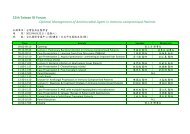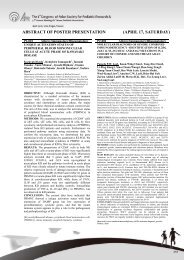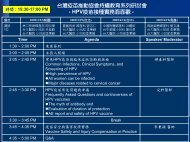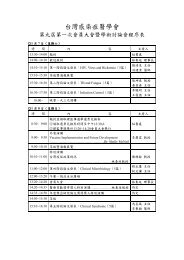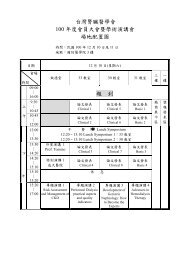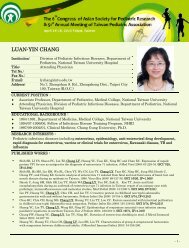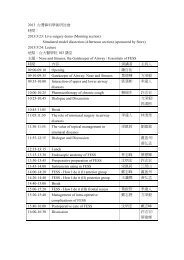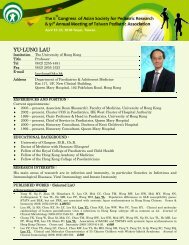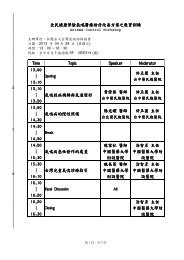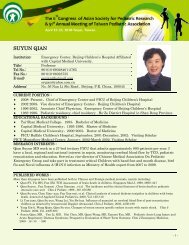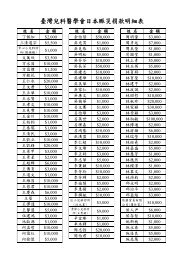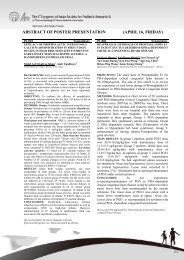ABSTRACT OF INVITED LECTURES AND ORAL PRESENTATION
ABSTRACT OF INVITED LECTURES AND ORAL PRESENTATION
ABSTRACT OF INVITED LECTURES AND ORAL PRESENTATION
- No tags were found...
You also want an ePaper? Increase the reach of your titles
YUMPU automatically turns print PDFs into web optimized ePapers that Google loves.
MS1-01DELAYED TREATMENT <strong>OF</strong> GRANULOCYTECOLONY-STIMULATING FACTOR RESTORESSYNAPTIC EFFICACY <strong>AND</strong> LONG-TERMFUNCTIONAL OUTCOME AFTER NEONATALASPHYXIA IN RATSSan-Nan YangProfessor and DirectorDivision of Neonatology, Department of Pediatrics, Kaohsiung MedicalUniversity Hospital and Graduate Institute of Medicine, TaiwanOBJECTIVE: Neonatal asphyxia is a leading causeof long-term neurologic disabilities varying frommild behavioural dysfunctions to severe seizure,mental retardation, and/or cerebral palsy amongst thenewborn. At present, adjunctive therapeutic optionand ongoing research into the pathophysiology ofneuronal injury after neonatal asphyxia in thedeveloping brain are still limited. Here, we reportthat granulocyte colony-stimulating factor (G-CSF)exerts multidimensional beneficial effects involvingrecovery of synaptic efficacy, neurogenesis, andlong-term functional outcome in the developingbrain after neonatal asphyxia.METHODS: Ten-day-old (P10) rat pups weresubjected to experimental hypoxia insult. G-CSF(10-50 g/kg, single injection/day, P14-19) wassubcutaneously administered to test animals andimmunoflourecin imaging with confocal lasermicroscopy, co-immunoprecipitation withimmunobloting, whole-cell patch-clampingtechnique, and chromatin immunoprecipitation wereused to analyse synaptic alterations within thehippocampal CA1 subregion (an essential integrationarea for mammalian learning and memory) (P20).The performance of long-term learning and memorywas assessed at later ages (P37-58).RESULTS: Delayed treatment of G-CSF reversedneonatal asphyxia-induced decreases in theexpression of phosphorylated cAMP-responsiveelement-binding protein-mediated signalling,synaptic plasticity, and neurogenesis, as well asbrain-derived neurotrophic factor (BDNF)expression through epigenetic modification withtrimethylation of lysine 4 on histone H3 in bdnfpromoter gene, corresponding to long-termfunctional outcome without introducing apparentadverse effects.INTERPRETATION: Using clinically relevanttherapeutic scheme of peripherally delayed treatmentwith G-CSF is able to promote a combined beneficialmechanism involving neurogenesis with synapticplasticity recovery, and improve long-term functionaloutcome in neonatal asphyxia animalsMS1-02THE EFFECT <strong>OF</strong> CYCLIC-AMP RESPONSE ELEMENTBINDING PROTEIN (CREB) ACTIVATION ONNEUROPROTECTION <strong>AND</strong> VASOPROTECTION INTHE DEVELOPING BRAINChao-Ching HuangNational Cheng Kung University College of Medicine, TaiwanHypoxic-ischemic encephalopathy is a major cause of neurologicaldisabilities in childhood. A new approach to studying treatment for neonatalhypoxic-ischemic encephalopathy is investigating states of tolerance.Tolerance is attained by preconditioning tissue to sublethal stress, whichcauses the tissue to become more tolerant of subsequent lethal insult.Although neurons are the cellular target of preconditioning, ischemictolerance occurring on vascular cells may also contribute greatly toneuroprotection. Elucidating the protective mechanisms of preconditioningmay offer potential therapies against hypoxic-ischemic brain injury.Our study showed that in 7-day-old rat pups, ligating the carotid artery 1 hbefore hypoxia damaged the ipsilateral cerebral hemisphere; in contrast,ligating the artery 24 h before hypoxia provided complete neuroprotection.The protective effect of the 24-h artery ligation preconditioning modelrequires the activation of cAMP response element-binding protein (CREB),a transcription factor implicated in synaptic plasticity, learning and memory,and survival of the nervous system. Vessels and nerves guide each other totheir target during development, and they use common signals, such asVEGF-A, to determine the fate of neurons and endothelial cells. BecauseVEGF-A is highly expressed in neurons and vessels throughout thedevelopment, VEGF-A may be a major protector through its dual neuronaland vascular effects in the developing brain. We tested the hypothesis thatVEGF-A/VEGFR-2 signaling that leads to CREB activation is the sharedpathway underlying the protective effect of preconditioning in neurons andendothelial cells. VEGF-A, VEGFR-1, or VEGFR-2 was inhibited byantisense oligodeoxynucleotides (ODN) in vivo, and by a VEGF-Aneutralizing antibody or VEGFR-2 inhibitor in vitro. CREB phosphorylation(pCREB), and VEGF-A and VEGFR-2 expression were increased andco-localized in vascular endothelial cells and neurons in the ipsilateralcerebral cortex 24 h post-ligation. The antisense ODN blockades ofVEGF-A and VEGFR-2 decreased pCREB and reduced the protection of24-h ligation preconditioning. Furthermore, oxygen-glucose deprivation(OGD) preconditioning upregulated VEGF-A, VEGFR-2, and pCREBlevels, and protected immortalized H19-7 neurons and b.End3 endothelialcells against 24-h OGD cell death. Blocking VEGF-A or VEGFR-2 reducedCREB activation and the effects of OGD preconditioning in neurons andendothelial cells. Transfecting a serine-133 phosphorylation mutant CREBalso inhibited the protective effect of OGD preconditioning. We concludethat VEGF-A/VEGFR-2 signaling leading to CREB phosphorylation is theshared pathway underlying the preconditioning-induced protective effect inneurons and vascular endothelial cells in the developing brain.We then tested the hypotheses that selectively activating VEGFR-2 withVEGF-E, instead of activating VEGFR-1 with placenta growth factor(PlGF), phosphorylated CREB and provided neuroprotection. We found thatVEGFR-2 instead of VEGFR-1 was expressed in vessels and neurons ofpostpartum day 7 rat brain. VEGF-A and VEGF-E treatment beforehypoxic-ischemia selectively activated VEGFR-2 and CREB, and providedprotection against hypoxic-ischemic brain injury. Furthermore, selectivelyactivating VEGFR-2 with VEGF-E instead of VEGFR-1 with PlGF afterhypoxic-ischemia also provided significant neuroprotection.These findings suggest that VEGFR-2, but not VEGFR-1, is pivotal forneuroprotection in the developing brain, and that pharmacological activationof VEGFR-2/CREB signaling may be an important strategy for treatingneonatal hypoxic-ischemic brain injury.55



